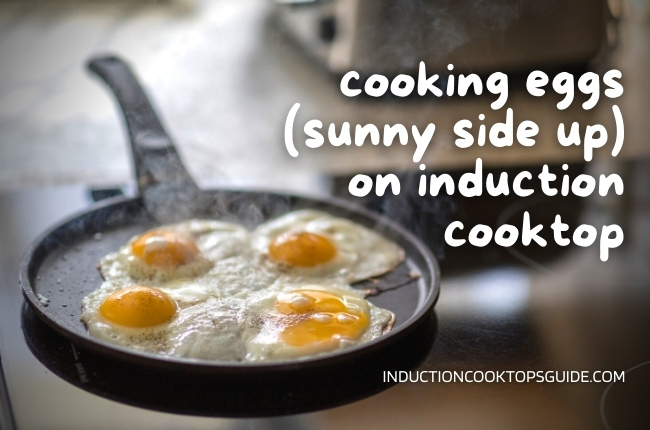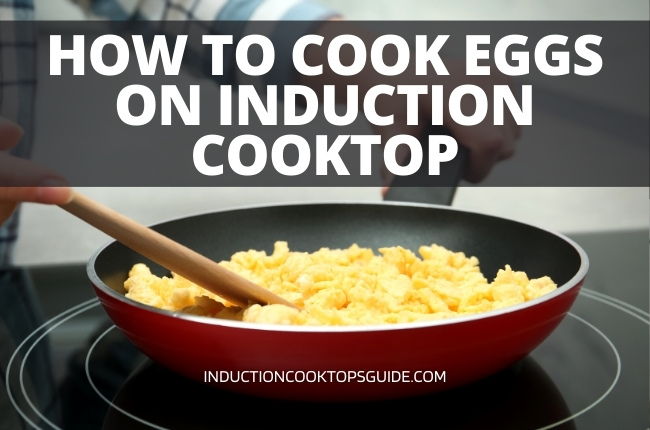Whether you’re an amateur cook or a pro in the kitchen, there’s always an egg dish you can make.
From a simple sunny-side up to a sophisticated poached egg, you’ll never go hungry if you always have eggs stocked up at home.
Although eggs take no sweat to cook, it can also be easy to mess them up if you use the wrong temperature and cooking time.
So if you’ve recently switched to an induction cooktop, you know how making your favorite dishes needs some adjustment since it cooks faster than other types.
So to help you make the perfect egg dish every time, we’ve come up with a handy guide on how to cook it on an induction stove below.
Can you fry with an induction stove?

If you prefer your eggs sunny-side up or over-easy, you’ll have no problem frying them on induction.
Some units even have a built-in fry setting that monitors the stove’s temperature. But if your cooktop doesn’t have that function, you can simply adjust the temperature according to the type of food you’re preparing.
If it’s your first time cooking eggs on an induction cooktop, you might need to do some trial and error on the first few tries.
Since eggs tend to cook quickly, you must determine the right temperature to get your preferred consistency. Starting at low or medium heat should help, and you can go from there.
What is the induction temperature for scrambled eggs?
Speaking of frying, cooking scrambled eggs on induction cooktop shouldn’t be as complicated as you think.
Scrambled eggs should only need medium heat to cook, which could take about 240°F (116°C). But since each induction stove has differing heating powers, you might need to adjust the temperature depending on your unit.
If your scrambled eggs take too long to cook at this temperature, you can increase the heat slowly. But if it’s too hot, turn down the heat by a couple of notches.
How long does it take to boil eggs on an induction cooktop?
Boiling is one of the easiest methods for preparing eggs, but getting the egg yolks at the right consistency takes a specific time.
If you remove the eggs from the heat too soon, you might have runny yolks that are difficult to repair.
So how long does it take to hard boil an egg in an induction cooker?
To be frank, the exact time you need will depend on several factors, including the size of your egg, the amount of water, and the volume of the pot you’ll use. But 10-12 minutes at 320°F (160°C) should be your safest bet to get the perfect hard-boiled eggs.
If you want to get the exact time for your unit, you can even cook several eggs simultaneously.
Let them boil for 3 minutes, and take one egg out in 30-second increments. When you find the right consistency, take note of the time, so you can use it the next time you want perfect hard-boiled eggs!
How to cook eggs on an induction stove
If it’s your first time switching to an induction cooktop, you should allow yourself an adjustment period to get used to your brand-new stove.
But to help you cut down on guesswork, here are several ways how you could make your eggs on induction:
1. How to fry eggs on an induction cooktop
Fried eggs are a breakfast staple since they pair well with bacon, sausages, or any of your favorite options.
Cooking them on an induction cooktop isn’t as far off as making them on other stoves.
- Heat oil or butter at 275°F (135°C) in a pan.
- Once it’s hot, crack 1 or 2 eggs into the pan. Let them cook until the egg whites solidify or their edges turn brown and crispy. You can also cover the pan with a lid to ensure the eggs are thoroughly cooked.
- If you prefer it over easy, flip the eggs with a spatula and let them cook for 1-2 more minutes.
- When the egg yolks are at your preferred consistency, transfer them to a plate and serve!
2. How to cook scrambled eggs on an induction cooktop
If you prefer your eggs scrambled and velvety, you can follow the steps below:
- Whisk 2 or 3 eggs, salt, and pepper in a bowl.
- Set your induction to 150°F (65°C), and melt 1 tablespoon of butter.
- Pour your scrambled egg mixture into the pan, stirring it constantly. After 2 minutes, increase the temperature to 185°F (85°C) and continue stirring until the egg is thick and fluffy.
- With a spatula, remove the scrambled egg from the heat and serve!
A non-stick pan will make it easier to stir and move the eggs. But you can also use stainless steel cookware, which becomes nonstick, as long as you heat it properly before adding in your scrambled egg mixture.
3. How to cook an omelet on an induction cooktop
The great thing about an omelet is that you can use any ingredient combination in one delicious dish.
You can go festive with sauteed mushrooms, ham, and bell peppers, or keep it understated with cheese and scallions. To make your version at home, just follow the steps below:
- In a bowl, whisk 2-3 eggs. Then, add salt, pepper, heavy cream, and any toppings you like.
- Melt 1 tablespoon of butter at medium heat.
- Add your omelet mixture, and cook for 1-2 minutes until most of the egg is ready. At this stage, you can add shredded cheese and fold the omelet in half.
- Let the omelet cook for 1-2 more minutes or until it’s golden brown, then transfer it to a plate and serve!
4. How to cook hard-boiled eggs on an induction cooktop
Although it’s simple, there are surprisingly several methods to prepare a hard-boiled egg. So we’ll cover a couple of ways how to hard boil eggs on induction cooktop below:
- In a pot, place the egg and fill it with water until the egg is completely submerged.
- Place the pot on your induction stove and cover it with its lid.
- Set your induction to 320°F (160°C), and boil the water for 10-12 minutes.
- Remove the egg from the heat, and transfer it to an ice bath (a bowl filled with ice and water). This will stop it from cooking from its residual heat.
An alternative cooking method is to turn the heat off once the water is boiling. Then, remove the pot from the stove while leaving the egg inside for another 10 minutes. Once the time is up, transfer the egg to cold water before peeling the shell – and serve!
5. How to cook soft-boiled eggs on an induction cooktop
Cooking soft-boiled eggs is similar to preparing their hard-boiled version, but you’ll need to use less cooking time so the egg yolks stay at a creamy consistency.
- In a pot, add water and let it simmer at medium heat.
- Use a slotted spoon to gently lower the egg into the water, and cover the pot with a lid.
- Let the egg cook for 6 minutes and 30 seconds. You can also set up the timer in your induction, so it can automatically turn off when it’s done.
- Once the time is up, remove the egg from the pot and place it in an ice bath before peeling off its shell.
6. How to cook poached eggs on an induction cooktop
You no longer have to wait to go to your favorite brunch spot to enjoy poached eggs when you can easily recreate them at home with your induction cooktop.
- To start, crack an egg into a small bowl.
- In a small saucepan, add water and 2 tablespoons of vinegar. Let it simmer at medium-high heat. You’ll know it’s ready when small bubbles start to rise to the surface.
- Reduce the temperature to medium heat. Then, stir the water with a spoon to create a vortex and immediately pour the egg. Be careful not to move the egg or pan for 2-3 minutes to prevent its shape from breaking.
- Use a slotted spoon to transfer the poached egg to a plate. Don’t forget to season it with salt and pepper, or top it with Hollandaise sauce for delicious Eggs Benedicts!
The bottom line
Eggs are one of the most versatile foods there is since you can serve them for breakfast, add them to sandwiches, or turn them into creamy egg salads.
But if you don’t use the right temperature and cooking time, you can easily under or overcook them. Practicing on your unit is the best method for mastering your favorite egg dish. But factors like egg size, amount of water, and power of your cooktop can affect your overall outcome.
We hope our quick cooking guide can help you cover the basics so you can get the perfect consistency every time you prepare them for your induction.

Leave a Reply